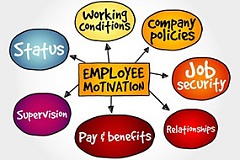If there’s one thing we can always count on, it’s the propensity for change. As the workplace continues to evolve, so too do the trends and challenges impacting human resources (HR) departments – even if you are a small company and you are the HR department.
As we head into Q2 of 2023, it's clear several key HR trends are dominating the business landscape. From employee well-being to talent shortages and hybrid work models, companies must be prepared to navigate these trends to attract and retain top talent. Here are what you can expect to see happening, and how to handle the changes.
Trend #1: The Employee Experience
One of the most significant trends in HR is the focus on employee experience. According to a recent survey, more than 80 percent of HR leaders believe that employee experience is critical to the success of their organizations.
Companies continue to prioritize the creation of a positive work environment that supports employee well-being, engagement, and growth. To achieve this, companies will need to focus on factors such as work-life balance, recognition, and career development opportunities.
Trend #2: A Human Approach to Employee-Manager Relationships
Another critical trend in HR is the shift toward a more human approach to employee-manager relationships. Rather than relying solely on performance metrics, companies are beginning to place a greater emphasis on building strong relationships between employees and their managers.
Taking this approach helps business owners recognize that their employees are human beings with unique needs and personalities, and that effective communication and feedback are important for building trust and fostering engagement.
Trend #3: Talent Shortage
These days, it’s harder to find good employees than it is to find a parking spot at the mall during the holiday season! The talent shortage is a significant trend expected to continue into Q3 2023, with only 25 percent of companies able to find the right talent for their positions without challenges right now.
With low unemployment rates and a competitive job market, companies must work harder than ever to attract and retain top talent. To do this, business owners must focus on creating a compelling employer brand, offering competitive compensation and benefits packages, and providing career growth and development opportunities.
Trend #4: Contingent Workers
Companies are increasingly relying on contingent workers to fill skills gaps and meet evolving business needs. According to one report, these workers will make up more than 50 percent of the workforce by 2027. This trend presents both opportunities and challenges for HR departments, as they must find ways to effectively manage and engage these workers while maintaining a positive company culture.
Trend #5: Perfecting Hybrid Work
With the rise of remote work, hybrid work models are becoming increasingly popular. In 2018, only 3.6 percent of the US workforce worked from home. By 2025, this number is expected to rise to 22 percent, according to this study by Upwork.
Companies must perfect their hybrid work models to ensure employees remain engaged and productive. This requires investments in technology, clear communication, and building a culture of trust and accountability.
Trend #6: Employee Visibility
Another significant trend in HR is the current emphasis on employee visibility. Businesses can improve engagement and motivation by giving employees greater visibility into company goals, progress, and performance. This includes regular communication and feedback, along with tools and platforms that enable employees to track their progress and collaborate with their colleagues.
A 2019 survey by Quantum Workplace found that companies with high employee visibility had 56 percent better engagement than those with low levels of visibility.
Trend #7: Employee Development
In 2023, businesses are placing a greater emphasis on employee development, with US companies now spending in excess of $100 billion over the past two years. This includes regular training and development opportunities to help employees grow and acquire new skills.
By investing in employee development, companies can boost engagement and retention while staying competitive in a rapidly changing business landscape.
Trend #8: Driving Employee Engagement
Finally, driving employee engagement will remain a critical focus for HR departments during the rest of 2023. Businesses can boost engagement and retention by creating a positive and supportive work environment that prioritizes employee well-being and career development while improving productivity and profitability. This contributes to building a robust culture both in the office and while working remotely.
An Employee’s Marketplace
A focus on the overall employee experience will characterize the HR trends expected between now and the end of 2023. Gone are the days when talented candidates lined up for a chance to work in your organization. Now, it’s an employee market second to none.
Companies must embrace these trends and create a positive work environment prioritizing employee well-being and career development. By doing so, businesses will attract and retain the top talent they need for success.
Resources:
- https://www.forbes.com/sites/johnbremen/2023/01/30/why-talent-shortages-persist-moving-beyond-the-great-resignation-and-quiet-quitting/?sh=97debe37139c
- https://www.outstaffer.com/posts/how-to-combat-the-talent-shortage-crisis-in-2023
- https://www.mckinsey.com/capabilities/people-and-organizational-performance/our-insights/the-great-attrition-is-making-hiring-harder-are-you-searching-the-right-talent-pools
- https://www.linkedin.com/pulse/understanding-your-contingent-workforce-importance-lee-willoughby/?trk=pulse-article
- https://teamstage.io/training-statistics/
- https://learnexperts.ai/blog/how-much-do-companies-spend-on-training-per-employee/
- https://trainingmag.com/2022-training-industry-report/
- https://www.the-future-of-commerce.com/2022/10/24/hr-trends-2023/
- https://www.cultureamp.com/blog/what-is-employee-experience
- https://www.hcmworks.com/blog/what-is-a-contingent-worker
- https://www.businessnewsdaily.com/15969-employee-engagement-ideas.html
- https://hrexecutive.com/how-to-embrace-the-new-world-of-hybrid-work/
- https://www.insightlink.com/blog/employee-visibility-engagement.cfm














